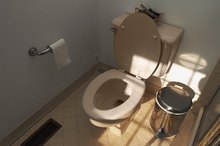Symptoms of an Infected Prostate
The prostate is a small gland in men that lies immediately beneath the bladder. A bacterial infection within the prostate, a condition called bacterial prostatitis, can cause uncomfortable symptoms in men 45. A male patient who develops symptoms of an infected prostate should seek care from a doctor to prevent further medical complications.
If you are experiencing serious medical symptoms, seek emergency treatment immediately.
Prostate Pain
Bacteria within the prostate can cause inflammation and irritation of this gland. If this occurs, men with an infected prostate can experience mild to severe sensations of pain within the prostate gland, explains Patient UK. Symptoms of pain can radiate from the prostate gland into the penis, anus, lower back or testicles. Pressure placed on the prostate gland during a bowel movement can exacerbate prostate pain symptoms in men with this type of infection. Without treatment, symptoms of pain due to an infected prostate can become progressively worse.
- Bacteria within the prostate can cause inflammation and irritation of this gland.
- Without treatment, symptoms of pain due to an infected prostate can become progressively worse.
Difficulty, Urgent or Painful Urination
Collapsed Bladder Symptoms
Learn More
The prostate gland wraps around the thin tube that carries urine out of a man's body, called the urethra. If the prostate gland is inflamed due to infection, the urethra may narrow. As a result, men with an infected prostate can experience difficulty urinating as a symptom of this condition. Inflammation within the prostate gland can also extend to the bladder, which can cause symptoms of frequent or urgent urination, report health professionals with FamilyDoctor.org 2. Certain men with this type of infection can also develop sensations of pain or burning during urination. Bladder irritation caused by a prostate infection can cause small amounts of blood to appear within a man's urine. These uncomfortable symptoms of an infected prostate can also be signs of alternate medical problems, such as a urinary tract infection. Affected men should seek prompt treatment from a medical professional.
- The prostate gland wraps around the thin tube that carries urine out of a man's body, called the urethra.
- These uncomfortable symptoms of an infected prostate can also be signs of alternate medical problems, such as a urinary tract infection.
Penile Discharge
Men with a prostate infection can develop unusual penile discharge as a symptom, warns Patient UK. A man may notice thick, discolored fluid around the head of the penis. Discharge from the penis can irritate the skin at the tip of the penis, which can contribute to sensations of burning or pain during urination.
Decreased Libido
Female Kidney Stone Symptoms
Learn More
Penile erection or ejaculation can exacerbate prostate pain symptoms in certain men. As a result, men with an infected prostate may experience a decreased interest in sex or can have difficulty becoming aroused during sexual stimulation, explains FamilyDoctor.org 2.
Flu-like Symptoms
General flu-like symptoms, such as fever, body aches or malaise, can arise due to an infection within a man's prostate, explains Patient UK. These flu-like symptoms can be uncomfortable and can contribute to headache, sweating or chills. Men who develop flu-like symptoms for any reason should be evaluated by a doctor as soon as possible.
Related Articles
References
- Patient UK: Acute Prostatitis
- National Kidney and Urologic Diseases Information Clearinghouse: Prostatitis
- The Merck Manual: Prostatitis
- UpToDate: Acute and Chronic Bacterial Prostatitis
- Roehrborn CG. Benign prostatic hyperplasia: an overview. Rev Urol. 2005;7 Suppl 9(Suppl 9):S3–S14. PMID: 16985902
- Lee CL, Kuo HC. Pathophysiology of benign prostate enlargement and lower urinary tract symptoms: Current concepts. Ci Ji Yi Xue Za Zhi. 2017;29(2):79–83. doi:10.4103/tcmj.tcmj_20_17
- Grozescu T, Popa F. Prostate cancer between prognosis and adequate/proper therapy. J Med Life. 2017;10(1):5–12. PMID: 28255369
- Benign enlarged prostate: Overview. InformedHealth.org [Internet]. Published January 25, 2018.
- Weiss JP. Nocturia: focus on etiology and consequences. Rev Urol. 2012;14(3-4):48–55. PMID: 23526404
- Serlin DC, Heidelbaugh JJ, Stoffel JT. Urinary Retention in Adults: Evaluation and Initial Management. Am Fam Physician. 2018;98(8):496-503. PMID: 30277739
- Rowe TA, Juthani-Mehta M. Urinary tract infection in older adults. Aging health. 2013;9(5):10.2217/ahe.13.38. doi:10.2217/ahe.13.38
- Rodgers M, Nixon J, Hempel S, et al. Diagnostic tests and algorithms used in the investigation of haematuria: systematic reviews and economic evaluation. Health Technol Assess. 2006;10(18):iii-iv, xi-259. doi:10.3310/hta10180
- Liu TT, Thomas S, Mclean DT, et al. Prostate enlargement and altered urinary function are part of the aging process. Aging (Albany NY). 2019;11(9):2653–2669. doi:10.18632/aging.101938
- Roehrborn CG. Benign prostatic hyperplasia: an overview. Rev Urol. 2005;7 Suppl 9(Suppl 9):S3–S14. PMID: 16985902
- Prostate Enlargement (Benign Prostatic Hyperplasia). National Institute of Diabetes and Digestive and Kidney Diseases. Published September 1, 2014.
- Pontari MA, Ruggieri MR. Mechanisms in prostatitis/chronic pelvic pain syndrome. J Urol. 2004;172(3):839–845. doi:10.1097/01.ju.0000136002.76898.04
- Litwin MS, Tan HJ. The Diagnosis and Treatment of Prostate Cancer: A Review. JAMA. 2017;317(24):2532-2542. doi:10.1001/jama.2017.7248
- Mandaliya H, Sung J, Hill J, Samali R, George M. Prostate Cancer: Cases of Rare Presentation and Rare Metastasis. Case Rep Oncol. 2015;8(3):526–529. Published 2015 Nov 26. doi:10.1159/000442045
- Palmerola R, Smith P, Elliot V, et al. The digital rectal examination (DRE) remains important - outcomes from a contemporary cohort of men undergoing an initial 12-18 core prostate needle biopsy. Can J Urol. 2012;19(6):6542-7. PMID: 23228289
- Chang RT, Kirby R, Challacombe BJ. Is there a link between BPH and prostate cancer?. Practitioner. 2012;256(1750):13-6, 2. PMID: 22792684
- De Angelis G, Rittenhouse HG, Mikolajczyk SD, Blair Shamel L, Semjonow A. Twenty Years of PSA: From Prostate Antigen to Tumor Marker. Rev Urol. 2007;9(3):113–123. PMID: 17934568
- Prostate cancer: Overview. InformedHealth.org [Internet]. Published February 22, 2018.
- Yu Y, Sikorski P, Bowman-Gholston C, Cacciabeve N, Nelson KE, Pieper R. Diagnosing inflammation and infection in the urinary system via proteomics. J Transl Med. 2015;13:111. Published 2015 Apr 8. doi:10.1186/s12967-015-0475-3
- James LJ, Wong G, Craig JC, et al. Men's perspectives of prostate cancer screening: A systematic review of qualitative studies. PLoS One. 2017;12(11):e0188258. Published 2017 Nov 28. doi:10.1371/journal.pone.0188258
- Feneley RC, Hopley IB, Wells PN. Urinary catheters: history, current status, adverse events and research agenda [published correction appears in J Med Eng Technol. 2016;40(2):59]. J Med Eng Technol. 2015;39(8):459–470. doi:10.3109/03091902.2015.1085600
- Colli E, Artibani W, Goka J, Parazzini F, Wein AJ. Are urodynamic tests useful tools for the initial conservative management of non-neurogenic urinary incontinence? A review of the literature. Eur Urol. 2003;43(1):63-9. doi:10.1016/s0302-2838(02)00494-3
- May M, Brookman-amissah S, Hoschke B, Gilfrich C, Braun KP, Kendel F. Post-void residual urine as a predictor of urinary tract infection--is there a cutoff value in asymptomatic men?. J Urol. 2009;181(6):2540-4. doi:10.1016/j.juro.2009.01.103
- Turkbey B, Pinto PA, Choyke PL. Imaging techniques for prostate cancer: implications for focal therapy. Nat Rev Urol. 2009;6(4):191–203. doi:10.1038/nrurol.2009.27
- Demaagd GA, Davenport TC. Management of urinary incontinence. P T. 2012;37(6):345–361H. PMID: 22876096
- Hall SA, Yang M, Gates MA, Steers WD, Tennstedt SL, McKinlay JB. Associations of commonly used medications with urinary incontinence in a community based sample. J Urol. 2012;188(1):183–189. doi:10.1016/j.juro.2012.02.2575
- Nickel JC. Comparison of trials with finasteride and dutasteride. Rev Urol. 2004;6 Suppl 9(Suppl 9):S31–S39. PMID: 16985923
- Chapple CR. A Comparison of Varying alpha-Blockers and Other Pharmacotherapy Options for Lower Urinary Tract Symptoms. Rev Urol. 2005;7 Suppl 4(Suppl 4):S22–S30. PMID: 16986051
- Lipsky BA, Byren I, Hoey CT. Treatment of bacterial prostatitis. Clin Infect Dis. 2010;50(12):1641-52. doi:10.1086/652861
- Welliver C, Helo S, McVary KT. Technique considerations and complication management in transurethral resection of the prostate and photoselective vaporization of the prostate. Transl Androl Urol. 2017;6(4):695–703. doi:10.21037/tau.2017.07.30
- Li M, Qiu J, Hou Q, et al. Endoscopic enucleation versus open prostatectomy for treating large benign prostatic hyperplasia: a meta-analysis of randomized controlled trials. PLoS One. 2015;10(3):e0121265. Published 2015 Mar 31. doi:10.1371/journal.pone.0121265
- Lorenzo G, Hughes TJR, Dominguez-Frojan P, Reali A, Gomez H. Computer simulations suggest that prostate enlargement due to benign prostatic hyperplasia mechanically impedes prostate cancer growth. Proc Natl Acad Sci U S A. 2019 Jan 22;116(4):1152-1161. Published Jan 2019. doi:10.1073/pnas.1815735116
Writer Bio
Rae Uddin has worked as a freelance writer and editor since 2004. She specializes in scientific journalism and medical and technical writing. Her work has appeared in various online publications. Uddin earned her Master of Science in integrated biomedical sciences with an emphasis in molecular and cellular biochemistry from the University of Kentucky College of Medicine.









